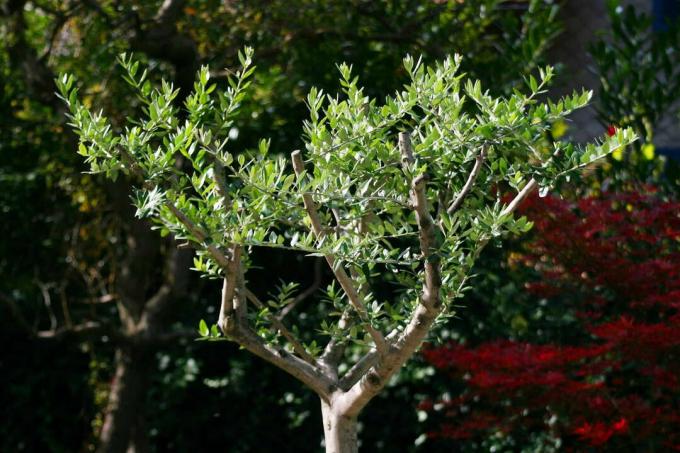The right pruning is part of the perfect care of an olive tree. But when is the right time and how much has to be cut?

There is far too much you can do when it comes to cutting yours Olive tree (Olea europea) don't go wrong. Especially when the tree is used as an ornament and no value is placed on a particularly high olive yield. Because an olive tree is extremely compatible with pruning and sprouts out of old wood again. This makes it the ideal bonsai for beginners. Nevertheless, a skilful cut back not only supports the look of the robust southerner, but also the well-being. We'll show you how to make the cut.
When should you prune olive trees?
The best time to cut the Mediterranean potted plants is in spring after wintering and before flowering. Smaller prunings can, however, be carried out all year round if there is no risk of frost. A sunny, warm, but not too hot day is best. This minimizes the stress that the tree is exposed to when it is cut. If you want to harvest olives, it is advisable to keep the pruning in early spring as moderate as possible, because the tree always sets the buds in the previous year. The more the annual shoots are shortened, the fewer the number of flowers and fruits.

Pruning an olive tree: a guide
The olive cut keeps the crown in shape and removes dead or diseased parts of the plant. Ventilation and adequate light supply in the crown are also important reasons for olive pruning. A distinction is made between three forms of pruning: the maintenance pruning, the educational pruning and the inner crown pruning. The conservation pruning can be carried out all year round. Here you remove:
- Dead plant parts
- Sick parts of plants
- Regrowing shoots on the trunk or in the root area
The education cut and the inner crown cut both serve to shape the crown. They are important for a long-term and orderly crown build-up. The two cuts can be made in one. To do this, proceed as follows:
- Plan the cut well in advance
- Use clean, sharp scissors
- Removal of sick and dead shoots
- Removal of shoots that grow inward or crosswise
- Shoots from the previous year are cut back in such a way that all leaves receive light
- Main shoots should be longer than the side shoots
- Larger wounds are closed with wound balm or wax
If the goal is to have a crown that is as dense as possible, several strong branches are cut back. This may be repeated for new shoots in early summer.
Note: Avoid cuts on the main shoots, because each main shoot has a main root. If you cut away one of the main shoots, the associated root will also die.
Should you cut the olive tree radically?
Actually, when pruning your olive tree, less is more. But every now and then a more radical pruning may be necessary, for example if the tree is not healthy. A healthy tree should not be cut back radically, because the olive tree needs a very long time in our climate to fill in the gaps that have arisen. If it is necessary, radical pruning is only ever done in spring. At this point, most of the strength is in the plants as they have rested in winter.
Another important maintenance measure is that Repotting olive trees. You can find more information here.



